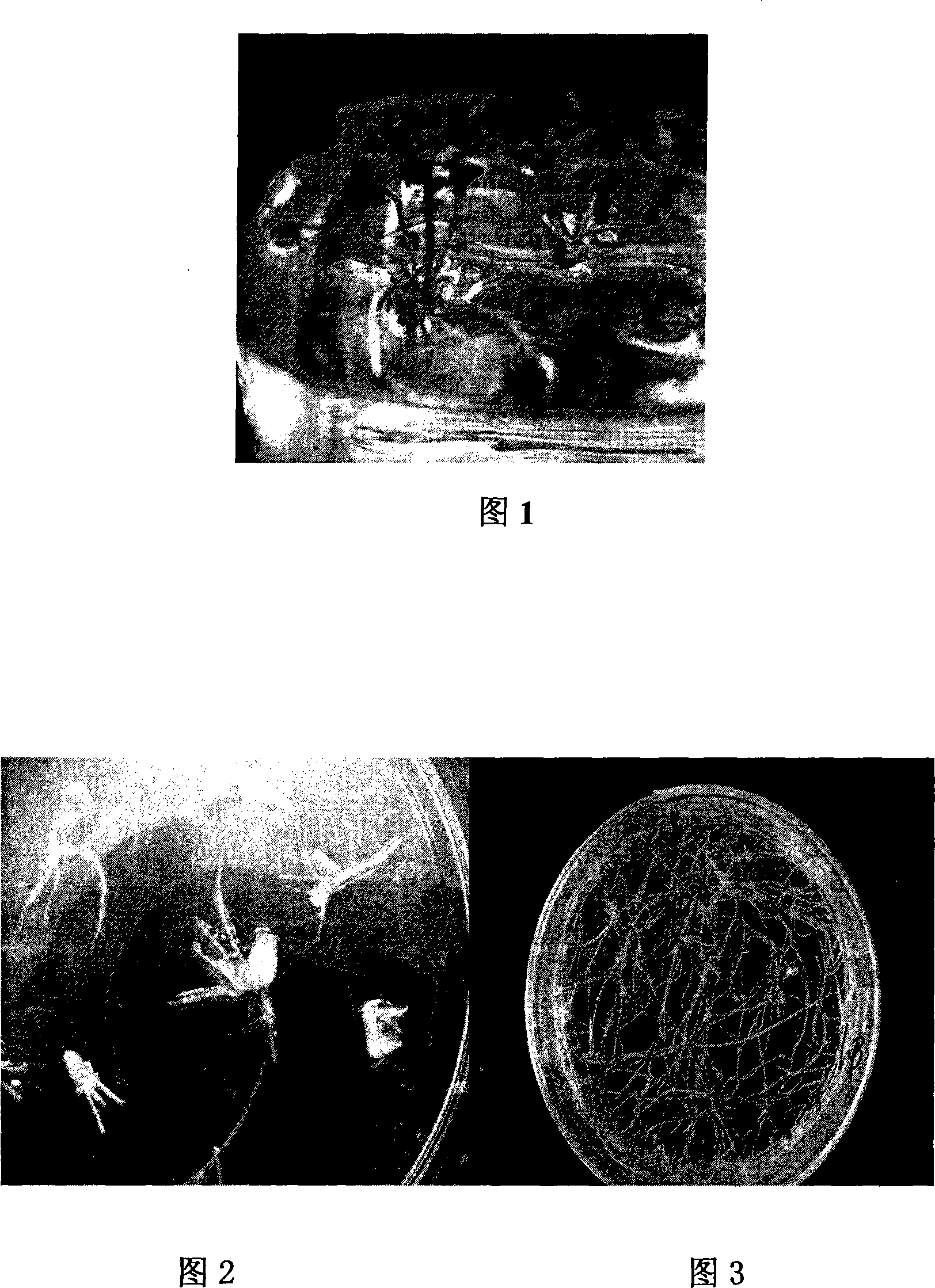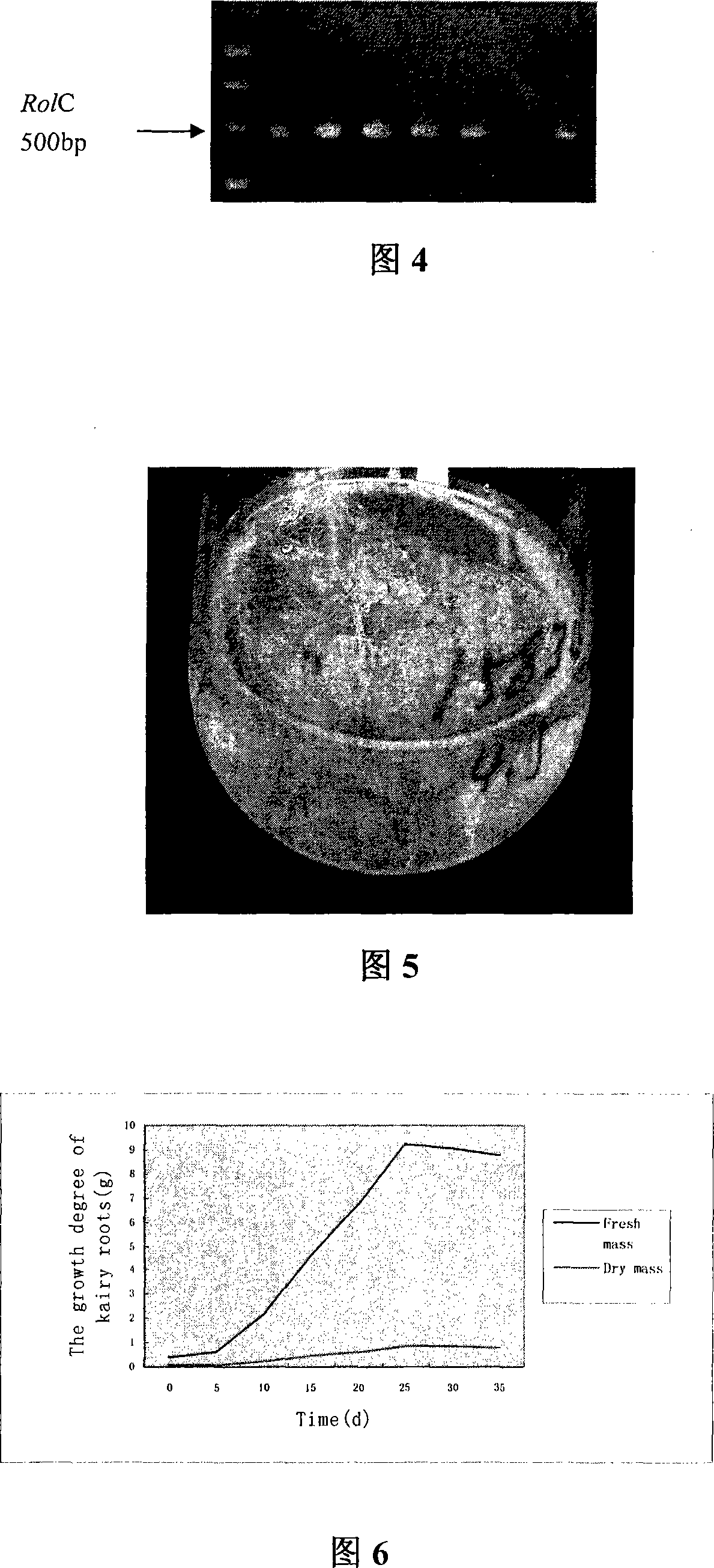Method for producing salidroside by using agrobacterium rhizogenes to inherit and transfer rhodiola sachdlinensis and constructing capillaceous root cultural system
A technique of genetic transformation of Agrobacterium rhizogenes, applied in the field of production of salidroside, which can solve the problems of affecting the quality of salidroside and increasing costs, and achieve the effect of not occupying the area of cultivated land, increasing yield and increasing growth
- Summary
- Abstract
- Description
- Claims
- Application Information
AI Technical Summary
Problems solved by technology
Method used
Image
Examples
Embodiment
[0037] 1 Obtaining sterile vaccines
[0038] Rhodiola rosea seeds collected from Changbai Mountain at an altitude of 1700-2500 meters were washed with tap water, soaked in 75% alcohol for 1 min, and then sterilized with 15% NaCl0 for 12 min. Then rinse with sterile water for 3 to 5 times, dry the water and inoculate on hormone-free 1 / 2MS+Pro700mg / L medium (0.6% agar) for germination and culture for 10 to 18 days. 25°C, light intensity 2000lux, 16 hours light, 8 hours dark culture. After 15 days, the aseptic seedlings grow out, and the green cotyledons (leaving about 2 mm of cotyledon petiole) of 3-day seedling age are placed on MS+0.5mg / LNAA+3.0mg / L 6-BA medium for subculture as shown in Figure 1 shown.
[0039] 2 pre-culture
[0040] Get the cotyledon nodes, stem segments and leaves of the subcultured aseptic seedlings, lightly scratch the dorsal and ventral surfaces of the leaves and cotyledons with petioles with a knife, cut the stem segments into 1 cm long as explants, ...
Embodiment 2
[0084] 3. Culture of Agrobacterium rhizogenes
[0085] Five kinds of Agrobacterium rhizogenes LBA9402 were inoculated on YEB solid medium for streak culture, activated three times at 27°C, picked a single colony on the plate, and inoculated in 25ml LB liquid medium. Cultured on a shaking table at 27°C, 4000r / min in the dark, and subcultured for 3 times, Agrobacterium rhizogenes liquid A 600 When it is 0.55, it is used to infect explants.
[0086] 4. Infection, co-cultivation, sterilization and screening of Agrobacterium rhizogenes
[0087] The above-mentioned pre-cultivated explants were immersed in the logarithmic phase bacterial solution A 600 rhizogenes LBA9402 bacterial solution with a concentration of 0.45-0.60, infect in the dark for 25 minutes, take out the excess bacterial solution with sterile filter paper, and place it in MS+NAA (0.05mg / L)+Pro 700mg / L medium After 2.5 days of co-cultivation, transfer to 1 / 2MS + kanamycin 50mg / L + cephalosporin 450mg / L + 80mmol / L a...
Embodiment 3
[0089] 3. Culture of Agrobacterium rhizogenes
[0090] Inoculate 5 species of Agrobacterium rhizogenes A4 on YEB solid medium for streak culture, activate 3 times at 27°C, pick a single colony on the plate, and inoculate it in 25ml LB liquid medium. Cultured on a shaking table at 27°C, 4000r / min in the dark, and subcultured for 3 times, Agrobacterium rhizogenes liquid A 600 When it is 0.50, it is used to infect explants.
[0091] 4. Infection, co-cultivation, sterilization and screening of Agrobacterium rhizogenes
[0092] The above-mentioned pre-cultivated explants were immersed in the logarithmic phase bacterial solution A 600 rhizogenes A4 bacterial solution with a concentration of 0.50, infect in the dark for 24 minutes, take out the excess bacterial solution with sterile filter paper, and place it on MS+NAA (0.05mg / L)+Pro 700mg / L medium for total After 2 days of culture, transfer to 1 / 2MS + kanamycin 50mg / L + cephalosporin 450mg / L + 90mmol / L acetosyringone medium, at 2...
PUM
 Login to View More
Login to View More Abstract
Description
Claims
Application Information
 Login to View More
Login to View More - R&D
- Intellectual Property
- Life Sciences
- Materials
- Tech Scout
- Unparalleled Data Quality
- Higher Quality Content
- 60% Fewer Hallucinations
Browse by: Latest US Patents, China's latest patents, Technical Efficacy Thesaurus, Application Domain, Technology Topic, Popular Technical Reports.
© 2025 PatSnap. All rights reserved.Legal|Privacy policy|Modern Slavery Act Transparency Statement|Sitemap|About US| Contact US: help@patsnap.com


